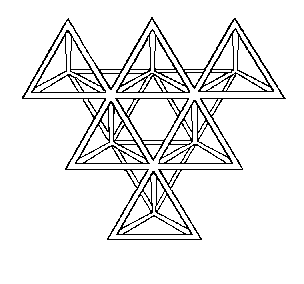
Return to Mark/Space
homepage
*note: The following is really an inadequate bit of waffle... written ages ago when it seemed that the 3D version was immanent.
Although this definitely is still the idea... it will take some time.
How does one create an electronic magazine that doesn't mimic the printed versions? How to take advantage of current technology to make something new and a bit different from what already exists? This was the challenge in formulating the look and feel of Mark/Space.
First, there was the question of capacity. With so much virtual room, how does one order the contents? Sequential sections, endless indexes, paging through reams of Helvetica or Times or even (gasp!) Courier? No way.
Hence the visual metaphor of the city... something familiar and natural for us to find things in. Logical, and yet Surprising.
Something also had to be done about the double curse of linearity and flatness. There are limits to flat presentations, even with the use of desktop window environments. The thought of seeing two-dimensional pages on a computer screen somehow seemed boring and very old-fashioned, despite their very electronic method of display.
Then there's the psychological aspect... the inability to penetrate beyond the page or beyond the screen... to see distant horizons or other dimensions. It's like standing with your face to the wall (no matter how attractive) and being unable to turn or move. Compared to this 'shallow' method of presentation, even the illusion of 'depth' seemed somehow better. So, the idea of adding perspective to Mark/Space developed from that.
I've always had a fascination with perspective in art. The wonderful ability -- through geometric trickery -- to 'draw' the reader in, to let the imagination view a space that wasn't there, to create a sense of boundless distance. One could easily imagine zooming into distant images and having them appear in detail close-up. Couldn't we somehow actually do that now?
Isn't virtual reality a form of perspective? Isn't ray-tracing a form of geometric trickery that allows one to shift viewpoints? Can't we 'paint' a landscape with light and set the information into it? This was the direction to explore. This was the logical layout.
Of course, a sophisticated virtual reality of this sort is still some way off. But there had to be a way to render a 3D look and feel to the presentation with current methods. So, with that goal in mind, a strategy was devised that would incorporate future developments in the design. By using CD-ROM to handle the visual data, and by pre-rendering 'corridors' of motion, it would be possible to create a functional 3D environment that would run on current home computers. Later, when the rendering speed of personal computers grew sufficiently fast to render in real time, the viewer would actually be able to move freely in any direction. In the meantime, a certain amount of movement would be pre-rendered as animation sequences, increasing the paths of motion with each new release.
The next objective was to tackle the problem of displaying the information within this context. With so many visual pyrotechnics taking place, computer memory would be be challenged beyond capacity. The solution seemed obvious. Freeze the rendering program when data was to be shown -- shifting from one software program to another while leaving the background scene as a ray-traced 'still' on the screen. And using the internet for handling the data.
This then is the approach we have chosen to take. I hope you like it. And you are cordially welcome to add to the matrix already started.
The developers of the rendering software used have very graciously and generously given us permission to include it with our first release. We also intend to include the source code to every building already constructed, so if you can improve upon it by all means do so and send me the results. -- Henry W.Targowski
*note: Since writing the above (the idea arose in 1993), there has been a lot of activity along these lines, as expected. At the same time, our original schedule -- which aimed for a March 1995 release -- had suffered a number of major setbacks. So, the full 3D version is still some way off (financial backing welcome).
However, I'm trying to markup as much of the data (personally researched and typed up over the years) as possible into Web pages, even if it's still only flat text.
Meanwhile, developments are afoot which could remove some of the original obstacles to real-time rendering. Therefore, I'm preparing as much of the contents as possible in anticipation of major breakthroughs.
Now that I have a web site started and my own personal e-mail address, it should be easier to keep everyone informed and involved. Many thanks for your enthusiastic support and generous offers of content. You've kept my spirits up.
